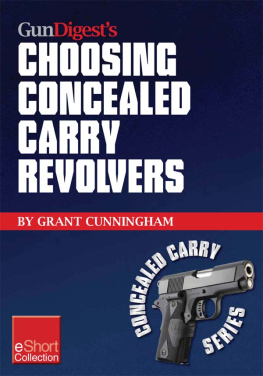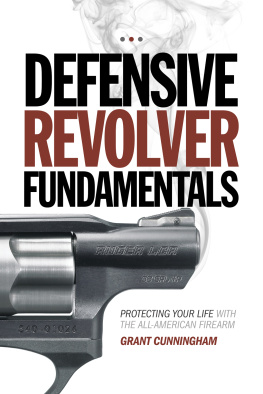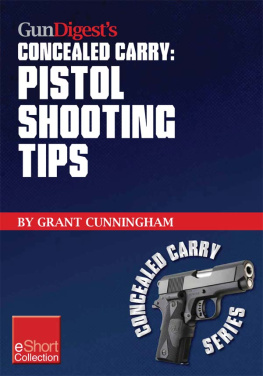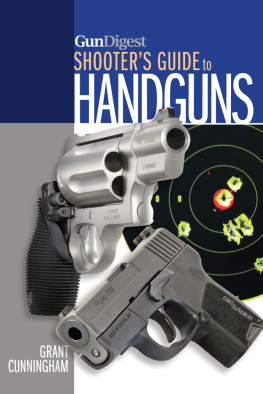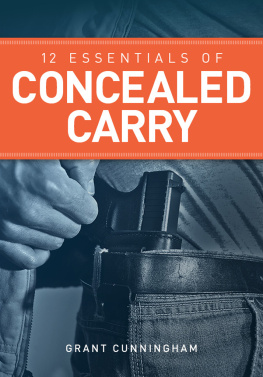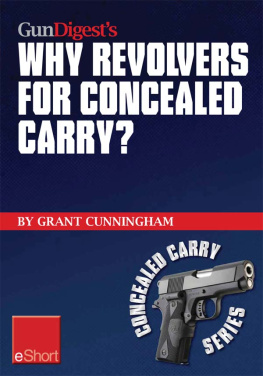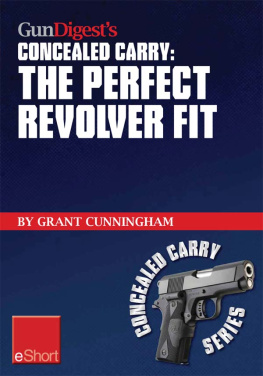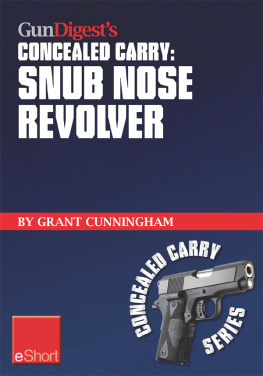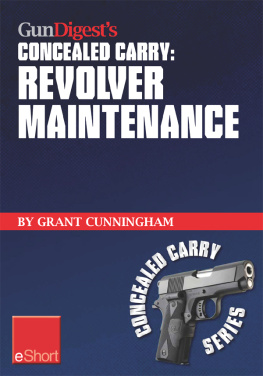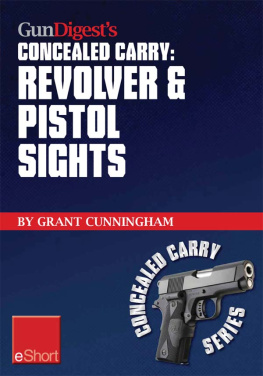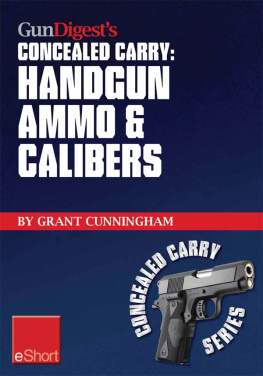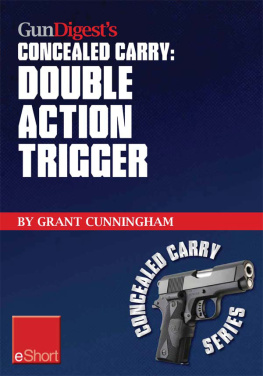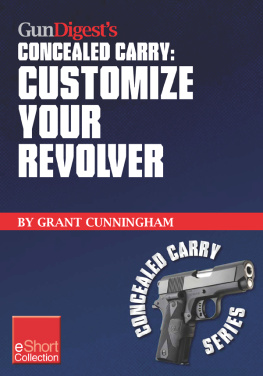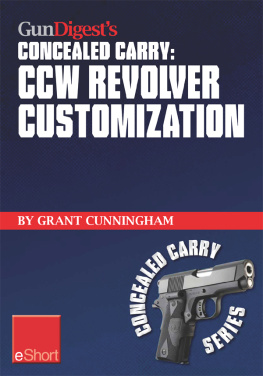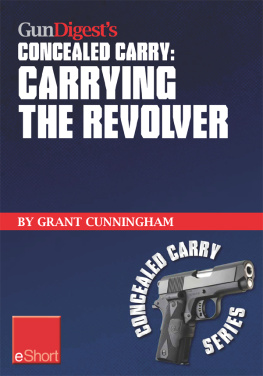Grant Cunningham - Gun Digests Choosing Concealed Carry Revolvers eShort
Here you can read online Grant Cunningham - Gun Digests Choosing Concealed Carry Revolvers eShort full text of the book (entire story) in english for free. Download pdf and epub, get meaning, cover and reviews about this ebook. year: 2012, publisher: F+W Media, genre: Romance novel. Description of the work, (preface) as well as reviews are available. Best literature library LitArk.com created for fans of good reading and offers a wide selection of genres:
Romance novel
Science fiction
Adventure
Detective
Science
History
Home and family
Prose
Art
Politics
Computer
Non-fiction
Religion
Business
Children
Humor
Choose a favorite category and find really read worthwhile books. Enjoy immersion in the world of imagination, feel the emotions of the characters or learn something new for yourself, make an fascinating discovery.
- Book:Gun Digests Choosing Concealed Carry Revolvers eShort
- Author:
- Publisher:F+W Media
- Genre:
- Year:2012
- Rating:4 / 5
- Favourites:Add to favourites
- Your mark:
- 80
- 1
- 2
- 3
- 4
- 5
Gun Digests Choosing Concealed Carry Revolvers eShort: summary, description and annotation
We offer to read an annotation, description, summary or preface (depends on what the author of the book "Gun Digests Choosing Concealed Carry Revolvers eShort" wrote himself). If you haven't found the necessary information about the book — write in the comments, we will try to find it.
In this excerpt from the Gun Digest Book of the Revolver, Grant Cunningham compares revolvers with semi-autos, details the pros and cons of each and helps you choose the best revolver for CCW.
Gun Digests Choosing Concealed Carry Revolvers eShort — read online for free the complete book (whole text) full work
Below is the text of the book, divided by pages. System saving the place of the last page read, allows you to conveniently read the book "Gun Digests Choosing Concealed Carry Revolvers eShort" online for free, without having to search again every time where you left off. Put a bookmark, and you can go to the page where you finished reading at any time.
Font size:
Interval:
Bookmark:

The revolver is still a viable choice for many kinds of shooting: recreation, hunting, or self defense.
Not that long ago the preferred handgun of both police and private citizens was the double action revolver. They were carried on duty, used to protect the home, shot in competition, and held their own as plinkers and fun guns. Their operation was well known, and learning how to properly handle their long, heavy triggers was a point of pride for many firearms instructors.
In the 1970s that started to change. The autoloading pistol was migrating from military service to law enforcement, and as it gained acceptance in those arenas the general public came to see the revolver as old-fashioned. By the end of the century the autoloader had almost completely replaced the revolver in police service -- and for a large percentage of private citizens as well.
Today its rare to see a revolver in a police duty holster. On occasion youll find a veteran officer carrying one, and in sparsely populated areas some cops prefer them for their ability to fire powerful, flat-shooting Magnum cartridges. Other than that the revolver has been relegated to the status of the backup: an arm used to supplant the primary arm should it become inoperable or lost.
Still, nearly forty percent of all handgun sales in the U.S. are revolvers. Thats because the revolver still has some advantages - some obvious, some not - over the ubiquitous autoloader.

Common malfunctions like this dont occur with a revolver.
The revolver is generally more reliable than an autoloader of similar quality. This isnt to say that malfunctions cant occur with a revolver, only that theyre less common. What malfunctions do occur are almost always a function of improper reloading technique (which Ill cover in a later chapter) or poor quality ammunition.
A malfunction that needs clearing is quite rare. The most common problem, a failure to fire, is usually solved by stroking the trigger again and using better ammo. Another common malfunction is a case caught under the extractor, which renders the gun inoperative until fixed. It is prevented by proper reloading technique.
There is a malfunction clearing process for the very rare instances not covered above, and Ill show you that, but needing to perform the drill is quite rare. Because of this inherent reliability, less training time is expended in malfunction drills which means more time for learning the important task of shooting!
A revolver doesnt need just the right grip to keep it running; there is no limp wrist malfunction with a wheelgun. Shooting from disadvantaged positions or while injured wont stop the gun from operating.
During an actual defensive encounter, the revolver is more resistant to induced failures. The revolver isnt jammed by clothing or incompletely ejected casings. With an autoloader, slight contact can actually slow the slide enough to induce a malfunction. Thats not an issue with the revolver, making it ideal for close-quarters defensive duties. The shrouded or concealed hammer models are about as immune to such problems as can be imagined.
Some defensive schools teach shooting while in contact with an adversary. Whether thats an appropriate response is beyond the scope of this book, but in such cases the revolver works perfectly where the auto can be jammed at the first shot.
Because of this its also possible to fire a revolver from inside a pocket without fear of malfunction. Shooting the revolver from inside a purse holster is also doable (and perhaps even necessary in the event of a purse grab.) An autoloader wouldnt be as reliable under those circumstances.
(Its important to understand that both autos and revolvers can be deliberately rendered inoperable by a very determined assailant. Its the inadvertent failures, those that are situationally caused, that arent a problem for the revolver.)
A revolver is easier to fit to the hand. An autoloader, even one of the few that feature interchangeable backstraps, is still limited by the dimensions of its magazine well. A revolvers grip can be easily changed to be longer, shorter, deeper, shallower, wider, or thinner. The angle at which the gun sits in the hand can even be altered on some models. In most cases its a cinch to make the revolver fit the hand perfectly.

The revolver is self contained, and doesnt need expensive magazines to operate.
One overlooked feature of the revolver is that it operates without ammunition. While Im not a big proponent of extensive dry fire, the fact that the revolver is fully functional without ammo means that dry fire training is more useful than it is with an autoloader. Theres no interruption in the firing cycle, so trigger control is learned faster than if you had to stop to constantly rack a slide. I dont know about you, but my brain learns best when it can experience a complete cycle of an event, and this is more easily done with the revolver.
The revolver is not only less expensive to purchase, its less expensive to operate as well. The gun itself tends to be less expensive than an auto of equal quality, but thats just the start!
If you have a defensive autoloader, its imperative that you test its function with the ammunition that you plan to carry. Recommendations vary, but the most common is that you shoot 200 rounds of that ammunition through the gun. If youve priced ammunition lately, you know how much that can cost!
With a revolver, you need to test your ammunition primarily to adjust the sights, or to verify that the bullet impact matches your non-adjustable sights. A couple of cylinders is all that takes, and you can then substitute cheaper practice or range ammo.
Of course there are no expensive magazines to buy. If you shoot your autoloader a lot, most authorities recommend that you have a half-dozen magazines for that gun. Thats a lot of money, and magazines are disposable parts: they wear out or can be damaged relatively easily. Thats an expense the revolver doesnt have.
Speaking of magazines, one of my favorite revolver attributes is that there arent any. Sometimes I go to the range with several guns, and when Im dealing with autoloaders more than once Ive forgotten to bring a magazine. The revolver doesnt have that problem because the magazine is part and parcel of the gun. Even many years from now a revolver bought today will still be operational, while Ive run into many autoloaders over the years that are missing their magazines.
I know Im picking on the magazine issue, but another point is that its impossible to load rounds into a revolver backwards. Ive seen more than one person load a round into a magazine backwards, and that causes a heck of a jam. Admittedly the incidence goes down with familiarization, but I remember one match I shot where a seasoned competitor loaded a round backwards in the middle of his magazine. Boy, was his face red!
Im not a fan of the word tactical, but there is one revolver advantage that fits the term: should you need to pick your gun up from a table (or even the ground), the protruding cylinder makes a small gap between the gun and the surface on which its resting. This makes it a bit easier to retrieve than an autoloader which rests flat on the surface. A small difference, to be sure, but one which could prove valuable in the event that you need to pick yours up in a hurry!
Font size:
Interval:
Bookmark:
Similar books «Gun Digests Choosing Concealed Carry Revolvers eShort»
Look at similar books to Gun Digests Choosing Concealed Carry Revolvers eShort. We have selected literature similar in name and meaning in the hope of providing readers with more options to find new, interesting, not yet read works.
Discussion, reviews of the book Gun Digests Choosing Concealed Carry Revolvers eShort and just readers' own opinions. Leave your comments, write what you think about the work, its meaning or the main characters. Specify what exactly you liked and what you didn't like, and why you think so.

